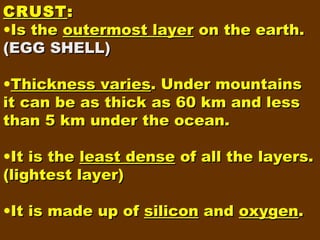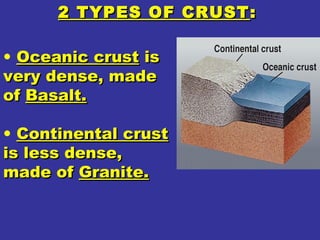EarthŌĆÖs layers
- 1. EarthŌĆÖs Layers SC Standard 8-3.1 Summarize the 3 layers of Earth on the basis of relative position , density and composition.
- 2. Earth is divided into 3 basic layers: 1. Crust 2. Mantle 3. Core These layers are then subdivided into smaller layers.
- 3. CRUST : ŌĆóIs the outermost layer on the earth. (EGG SHELL) ŌĆóThickness varies. Under mountains it can be as thick as 60 km and less than 5 km under the ocean. ŌĆóIt is the least dense of all the layers. (lightest layer) ŌĆóIt is made up of silicon and oxygen.
- 4. 2 TYPES OF CRUST : ŌĆó Oceanic crust is very dense, made of Basalt. ŌĆó Continental crust is less dense, made of Granite.
- 6. MANTLE : ŌĆó Located below the crust. (Egg White) ŌĆó It is the largest layer (about 2900 km thick). Rock layers are movable. (plastic) ŌĆó Hot soften rocks made up of more magnesium and iron. ŌĆó Density increases with depth due to increase in pressure.
- 7. MANTLE : Divided into 2 parts ŌĆó Upper mantle ŌĆó Lower mantle. ŌĆó Contains the ŌĆ£MohoŌĆØ (Mohorovicic discontinunity)
- 8. CORE : (Egg Yolk) ŌĆó Located below the Mantle. ŌĆó It is divided into 2 layers Outer Core Inner Core
- 9. Outer Core : ŌĆó is liquid and is made up of mostly iron (easily magnetized) ŌĆó The movement of materials in the liquid O.C. is inferred to be the cause of EarthŌĆÖs magnetic field! (highlight in your notes) ŌĆó The O.C. is about 2250 km thick.
- 10. Inner Core : ŌĆó Is the center of the Earth ŌĆō 1200 km thick. ŌĆó ItŌĆÖs solid iron and nickel. Most dense layer (heaviest) (highlight in notes) ŌĆó The increased pressure causes the I.C. to be solid
- 11. In your notes lets draw together a diagram of the Earth. CRUST MANTLE OUTER CORE INNER CORE
- 13. Look at the sub-layers of the mantle LITHOSPHERE: ŌĆó This is the ŌĆ£crunchyŌĆØ layer of the Earth. ŌĆó It includes the crust and the very uppermost part of the upper Mantle ASTHENOSPHERE: ŌĆó Soft ŌĆō can bend like plastic, layer in the upper portion of the mantle ŌĆó It is located right below the Lithosphere. Lithosphere floats on this layer (like jello)
- 14. Lithosphere CRUST Asthenosphere MANTLE OUTER CORE INNER CORE
- 15. In Review: 1.What are the 3 main layers of the Earth? Crust, Mantle, Core 2.Which layer is the least dense? Crust 3.Which core layer is solid iron and nickel? Inner core 4.What is the name given to the ŌĆ£crunchyŌĆØ layer of the crust and uppermost part of the mantle? Lithosphere 5. The motion in this layer is the reason Earth has a magnetic field. Outer core














